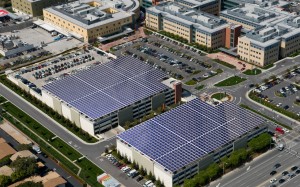Santa Clara medical center's solar prescription


Healthcare provider Kaiser Permanente has flipped the switch its latest solar installation, an 895-kilowatt system at the Kaiser Permanente Santa Clara Medical Medical Center that will provide roughly 8.5 percent of the facility's power needs.
The installation is just the latest in a 15-megawatt solar power commitment that the company made in March 2010 with its clean energy partner, Recurrent Energy. Overall, 15 Kaiser Permanente sites in California are supposed to begin using solar power, including the Vallejo Medical Center, a facility in Livermore, and medical offices in Lancaster and La Mesa. Recurrent Energy is handling all the installations, and it will retain ownership of the systems. Kaiser Permanente pays a fixed, negotiated rate through a power purchase agreement with Recurrent Energy.
John Kouletsis, the non-profit healthcare provider's director of strategy, planning and design for national facilities, told me that the Santa Clara installation took about three months to go live, which is fairly typical of the other installations that the organization completed during the last year. Several other sites should go live this winter, with others planned for the spring, he says.
He has these words of advice for other organizations planning a solar investment to increase its clean energy mix:
- Do your homework on financing options. This may seem a no-brainer, but when the Kaiser Permanente team began thinking about buying solar it discovered that it would be a trailblazer. There were few examples from which it could draw, and it took almost 18 months to explore its options and fix on a specific course of action, Kouletsis says. Getting the treasury and finance team involved form the beginning was a key factor for progress, he notes.
- Make sure you have high-level support. The Kaiser Permanente board didn't need much convincing. After all, the organization has committed to using sustainable design practices to create more than 6.7 million square feet of green buildings over the next six years. And the company already has saved roughly $10 million through energy conservation. But Kouletsis says "dedication at the executive level was instrumental and important" in getting the solar installations to happen. "If you don't have this, you need to work on this," he says.
This post was originally published on Smartplanet.com